The Rambler
17.11.05
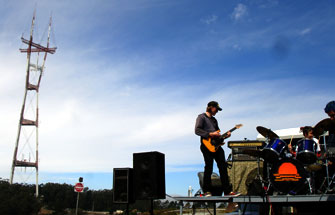 I got a girlfriend. You can’t have her. I got a racetrack in my yard. I got an A-frame. I got a speedway. I got a goofball in my hand. She’s a winner. I got a racecar. It’s kind of a sculpture. I got a Rambler in my yard…
I got a girlfriend. You can’t have her. I got a racetrack in my yard. I got an A-frame. I got a speedway. I got a goofball in my hand. She’s a winner. I got a racecar. It’s kind of a sculpture. I got a Rambler in my yard…
On a certain morning, a certain dawn, twenty three seagulls formed a circle pit in the sky above the calm, glassine but deceptively fetid waters of Tire Beach, at the end of 24th Street in San Francisco, a battered wasteland of a public park, piles of trash, overgrown weeds rapidly forming a more permanent bark skin, remnants of smashed concrete, a twisted chainlink fence.
Tire Beach, known on city maps as Warm Water Cove, is probably one of the top three neglected designated public parks in the city, with layers of graffiti seemingly holding up the walls, normally the only signs of human presence, signals that the park is actually being used, albeit for illegal purposes that city planners had, in fact, not planned for. But this particular morning something different floats in the air, while fishing through the darkness, the trailers, the vans the broken down RVs that some people call home, there are the sounds of a cello, a Moog, a gas generator’s hum, hushed voices and the cackle of fire. Ahead of us: the Rambler.
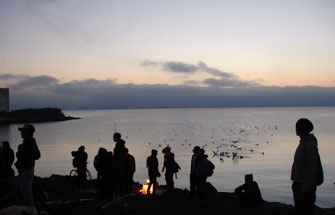 It’s a slightly modified moving truck, the kind whose rates U-Haul would like to puppeteer up and down like a ping-pong ball in the proverbial gas tank, as they did after this hurricane season’s devastating storms in America’s south. It’s true, (and sorry for a bit of a ramble here but) U-Haul actually seemed to raise equipment prices along with the rising cost of gas and oil. See the corporate thought process? High gas prices will cause equipment usage to be more expensive through their use alone; so why not raise equipment prices under the guise of matching the rising cost of oil to maximize profits. It’s the American way to capitalize on tragedy….
It’s a slightly modified moving truck, the kind whose rates U-Haul would like to puppeteer up and down like a ping-pong ball in the proverbial gas tank, as they did after this hurricane season’s devastating storms in America’s south. It’s true, (and sorry for a bit of a ramble here but) U-Haul actually seemed to raise equipment prices along with the rising cost of gas and oil. See the corporate thought process? High gas prices will cause equipment usage to be more expensive through their use alone; so why not raise equipment prices under the guise of matching the rising cost of oil to maximize profits. It’s the American way to capitalize on tragedy….
Anyway, the Rambler exists in both physical shape and metaphysical space. The brainchild of curator Tina Gordon, the Rambler is one part mobile soundstage, a traveling, squawking box truck with its grey and flat black exterior still smelling of spray paint, its interior cabin shining like fresh orange-custard-and-crème soft serve, and its cargo space neatly organized to slide three step-stages in and out, as well as fit amps, monitors and instruments of the rotating, numbering nearly 40 musicians that will play throughout the day. The musicians, ranging from mostly metal bands like Acid King, Hightower, Comets on Fire, Neurosis, The Fucking Champs, Old Grandad, Six Organs of Admittance, Om, and Hello Noisy among others, play under the name “Universe,” and partially compose the other part of the Rambler. That is to say, the artsy-fartsy component.
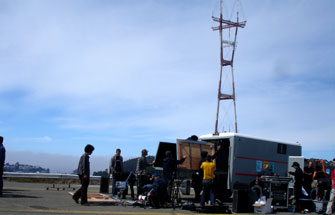 Imagine a line extending from the earth’s equator infinitely outward through the sky and the clouds and the atmosphere and past the stars and planets, galaxies unknown, hunks of metal and minerals. One particular day every year the sun appears to cross this line extending into the sky, and depending on where one might be standing on that particular day, it marks the coming of winter or summer, in the simplest sense.
Imagine a line extending from the earth’s equator infinitely outward through the sky and the clouds and the atmosphere and past the stars and planets, galaxies unknown, hunks of metal and minerals. One particular day every year the sun appears to cross this line extending into the sky, and depending on where one might be standing on that particular day, it marks the coming of winter or summer, in the simplest sense.
The earth’s axis, which is tilted at an angle of 23.5 degrees, appears to be at right angles with the sun, as the North Pole begins to shift away from the sun and the South Pole begins to welcome warmer skies. In San Francisco, this date (September 22, 2005) is known as the autumnal equinox. In the Southern Hemisphere, this name has less significance, however both hemispheres experience a rare, though entirely expected, night/day equality.
Tina Gordon shrewdly planned this maiden voyage of the Rambler to coincide with this date, and with one of those artsy touches, wrote a 12-hour composition with designs toward following the sun’s movement across the sky, reinterpreting its distance from the earth in the form of beats per minute.
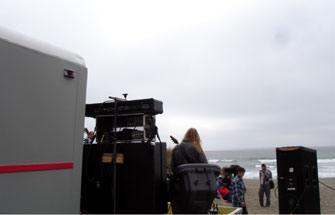 As explained on the project’s web site, the Rambler’s 12-hour composition is “a live performance concept soundscape, which seeks to answer the question ‘what does light sound like?’” … or rather “an amplified sound interpretation of the Sun’s proximity to the Earth as expressed on the autumnal equinox, defining a relationship between light, sound and the space they inhabit. This composition will be expressed through the rise and fall of a symmetrical BPM scale, synchronized to the Sun’s 12-hour trajectory.”
As explained on the project’s web site, the Rambler’s 12-hour composition is “a live performance concept soundscape, which seeks to answer the question ‘what does light sound like?’” … or rather “an amplified sound interpretation of the Sun’s proximity to the Earth as expressed on the autumnal equinox, defining a relationship between light, sound and the space they inhabit. This composition will be expressed through the rise and fall of a symmetrical BPM scale, synchronized to the Sun’s 12-hour trajectory.”
Gordon wrote the piece so that the musicians, ranging from three to seven in a group, would play for 20-minute intervals, incrementally increasing the BPM by 10 for each group until the sun reached its pinnacle around noon. As the sun begins its declination, the BPM would then decrease by 10 until 6pm PDT.
An interesting concept: marking the relative distance of the sun by sound. But the Rambler also marks physical distance in this equation. Being a self-described “vessel of infinite possibility,” the Rambler (the motorcar and the project) traversed the city, following the sun’s arc across the sky, from its eastern starting point at the trashy Tire Beach at sunrise to between the tits of Twin Peaks, one of the city’s highest points (excepting the penthouse suite at Jones and Green), and concluding at Ocean Beach at sunset.
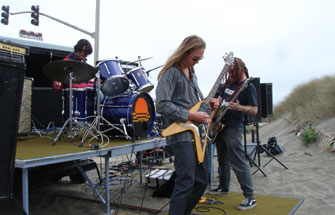 We arrived at the Rambler in proper and well-disciplined journalistic order from its easterly embarkation where homeless stoner punks danced around a fire made from pallet wood scraps and cardboard. People spoke in whispers. We drank coffee and got unsolicited advice from an amateur photographer. By the time the music shifted from the Godspeed-esque welcoming of the dawn and slipped into black metal, the sun was shining off the metal plated amps, making them glint like they were some holy object.
We arrived at the Rambler in proper and well-disciplined journalistic order from its easterly embarkation where homeless stoner punks danced around a fire made from pallet wood scraps and cardboard. People spoke in whispers. We drank coffee and got unsolicited advice from an amateur photographer. By the time the music shifted from the Godspeed-esque welcoming of the dawn and slipped into black metal, the sun was shining off the metal plated amps, making them glint like they were some holy object.
It felt cheesy to say this was atavistic behavior; watching the sunrise in some sort of pagan, reverential sense. Instead of a golden cow our eyes were squinting from the light refracted by golden amps, and there was mild annoyance at the idea that this was becoming some kind of event, of which we should be welcoming the miracle of the sun. The feeling was momentary, however, and at this age, watching the dawn usually comes under much worse circumstances—overnight drunks, broken down cars, broken homes, broken hearts and swollen lips.
An interesting corollary to this project—marking relative time and space of celestial objects through sound—would be the Radio Astronomy installation by radioqualia at the NTT Inter Communication Center in Tokyo last spring. Instead of creating sound to represent distance or sending radio waves into the cosmos, the installation focused on sounds created in the Universe and collected through radio telescopes throughout the world (for an mp3 stream of these collected sounds see http://www.radio-astronomy.net/listen.htm).
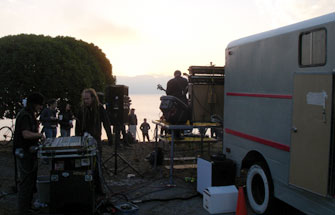 According to its site, “[B]y publicly broadcasting sounds intercepted from radio telescopes, Radio Astronomy enables listeners to tune into to different celestial frequencies, hearing planets, stars, nebulae, and the constant hiss of cosmic noise. It reveals the sonic character of objects in our galaxy, and in the process perhaps make these phenomena more tangible and comprehensible. The project is indeed radio astronomy in the strict sense – a radio station devoted to broadcasting sounds from space.” The hisses, clicks, erratic screeches, near cricket-like chirps, pops and cracks from the stream sound a lot like the squawking speakerbox on the Rambler vehicle as well as the loop played for continuity between the composition movements. Even further, Radio Astronomy references Johannes Kepler’s third law of planetary motion (albeit in an obtuse, avant garde way), which “related planetary movements to musical scales and intervals.” While this may not be entirely accurate, Kepler was of the thinking that planets must move according to a common set of mathematical relations, which is similar to the Pythagorean discoveries of mathematical relations between musical tones. In any event, this sounds, in fact, more applicable to the Rambler project.
According to its site, “[B]y publicly broadcasting sounds intercepted from radio telescopes, Radio Astronomy enables listeners to tune into to different celestial frequencies, hearing planets, stars, nebulae, and the constant hiss of cosmic noise. It reveals the sonic character of objects in our galaxy, and in the process perhaps make these phenomena more tangible and comprehensible. The project is indeed radio astronomy in the strict sense – a radio station devoted to broadcasting sounds from space.” The hisses, clicks, erratic screeches, near cricket-like chirps, pops and cracks from the stream sound a lot like the squawking speakerbox on the Rambler vehicle as well as the loop played for continuity between the composition movements. Even further, Radio Astronomy references Johannes Kepler’s third law of planetary motion (albeit in an obtuse, avant garde way), which “related planetary movements to musical scales and intervals.” While this may not be entirely accurate, Kepler was of the thinking that planets must move according to a common set of mathematical relations, which is similar to the Pythagorean discoveries of mathematical relations between musical tones. In any event, this sounds, in fact, more applicable to the Rambler project.
We followed the Rambler up to Twin Peaks at around 11AM, where the tempo picked up quite a bit for an hour at the sun’s zenith with Antonio Roman (who plays in Dear Nora with his mom) rocking out on drums and Dave Edwardson from Neurosis, while buses full of bewildered tourists made their way around the figure-eight loop at the top of the Peaks. In the background, San Francisco’s massive radio tower hovered overhead and the sky was cerulean. By the time we reached Ocean Beach at Noriega the sky was overcast and the beer was flowing. In true and proper journalistic fashion, we drank the free beer and left early.